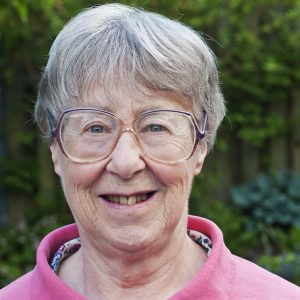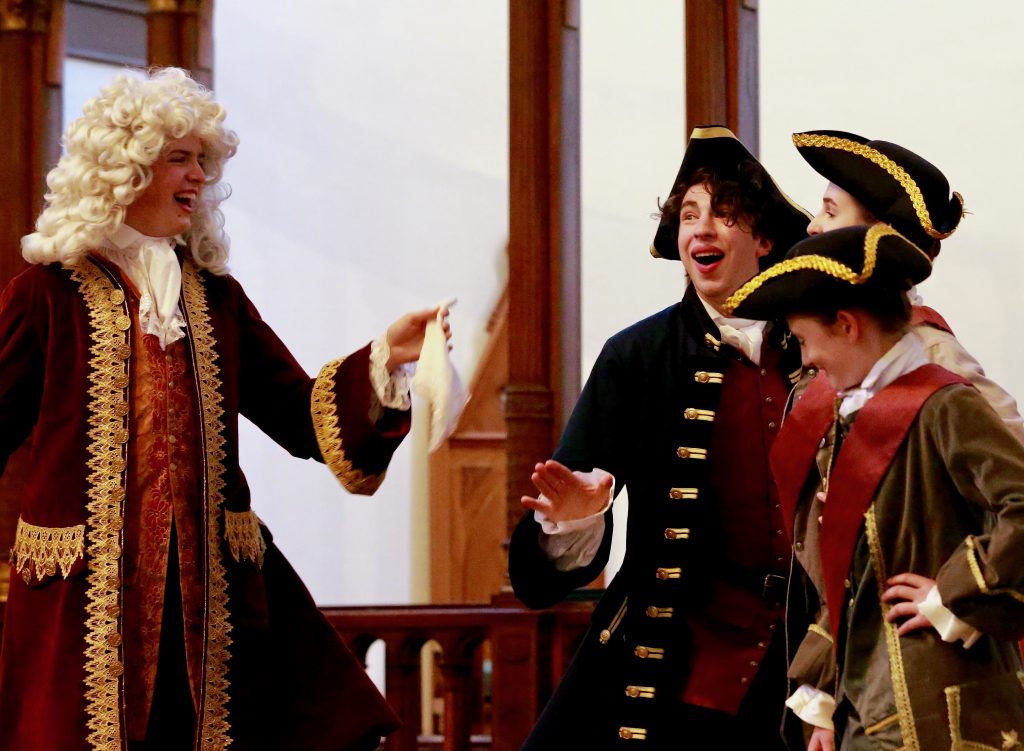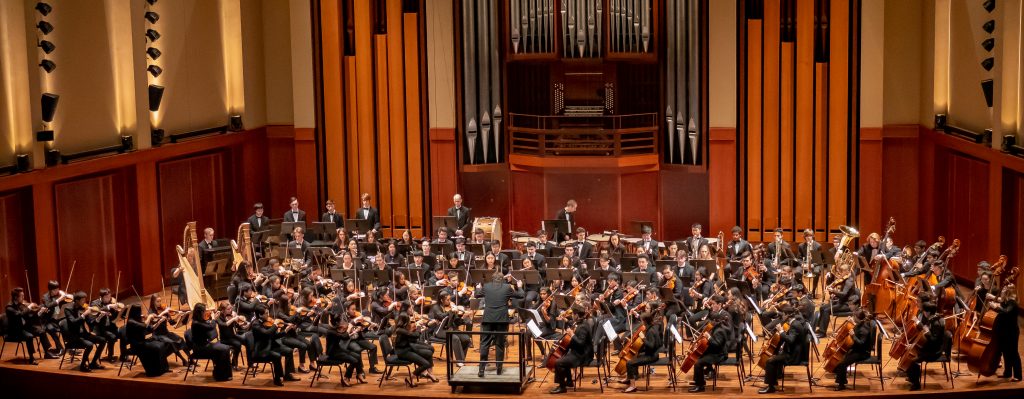By Philippa Kiraly, Special to The Sybaritic Singer
In a world where it’s often a premise that classical music is only for older people, it is refreshing to go to a show where the performers are all children, a show where the young people are well-trained, the performance is enjoyable and high quality, and it’s in a classical genre. Over two recent weekends in March 2019, three highly-regarded Seattle organizations presented performances by children: Seattle Opera’s Youth Opera Project gave four performances of Ben Moore’s Odyssey at Cornish Playhouse, Seattle Youth Symphony Orchestra gave a concert at Benaroya Hall, playing Ravel, Schumann and Mahler and, at Christ Episcopal Church, Seattle Historical Arts for Kids presented the pageant of Master Finno’s Songbook, an original pageant based on a song collection first published in 1582
The productions, though, are only the tip of the iceberg.
Seattle Opera’s Youth Opera Project
Seattle Opera’s Youth Opera Project (YOP), now starting its third season, began as a Youth Opera Chorus for the main stage productions, and the idea of having actual operas for children to perform grew out of that. Previously there had been Opera-run summer camps which over a period of weeks learned and put on performances of works such as a truncated Gilbert & Sullivan operetta. While these were great fun and good experience for the children, they were essentially performances for family and friends with minimal costumes, stage set and so on.
Each year, YOP performances have developed markedly from the previous year. Last year’s Robin Hood (also composed by Moore) gave way to this year’s Odyssey. For Odyssey’s full professional production this month, YOP had a panoply of staff: teaching artists, music and stage directors, choreographer, design, and production teams. “Everyone,” says Alejandra Valerino Boyer, the Opera’s Director of Programs & Partnerships, “with the exception of the design team, rehearsed with the young people twice a week through the five-month rehearsal process.” That’s ninety rehearsal hours, so to be part of the YOP means considerable commitment on the part of the children (as well as their parents). “This year we had 76 students,” she says. “The students all audition so that we can assess their skill level, but anyone who auditions is accepted into the program,” and no one is turned away for lack of funds. Youth and Family Program Manager Sara Litchfield is the hands-on person who oversees YOP.
To help kids prepare, the Opera runs a Teen Vocal Studio (TVS), the successor to the Opera’s Teen Vocal Players, which is a free, auditioned training program for young people hoping to go on to a degree in vocal performance. Most of the soloists in Odyssey were part of this—and astonishingly, YOP fielded twenty soloists in the double cast, plus fifty more kids for the chorus of sirens, sailors, and piggies. Most of the solo singers also had individual coaching either from their own teachers, such as Seattle’s Nancy Zylstra or from TVS’s own Liz Fisher.
Several of the instrumentalists in the small ensemble which accompanied Odyssey were also teenagers. It’s part of the experience for them that “YOP participants not only receive training in various performance disciplines (singing, acting, dance), but they get to participate in the process of presenting an opera that closely resembles the process for any professional production,” comments Boyer.
Additionally, the TVS participants get to go to Seattle Opera rehearsals, have masterclasses with artists from Seattle Opera productions, and go to career specific workshops which is wonderful training for any aspiring singer. All this is not cheap, and there is quite a stiff fee to join YOP but there are scholarships and financial help and Seattle Opera picks up the slack.
It’s a wonderful program and quite a few young people go on to study voice in college with this excellent preparation under their belts.
Seattle Historical Arts for Kids
Seattle Historical Arts for Kids (SHAK) is a much smaller organization but it fills a rarely occupied niche, introducing pre-college kids from age six to teenagers to period performance.
SHAK had its origins in 2005 as a series of historical day camps for children, the brain child of Shulamit Kleinerman, a scholar/musician who plays medieval vielle and Renaissance violin, and who created the camps to explore music, dance, crafts and stories from the 12-18th centuries. Her idea grew to include year-round workshops and classes for instrumentalists in an Early Music Youth Academy. Children began to come back year after year and SHAK began to give concert of early songs, in 2010 creating its first CD.
Staged performances began in 2011, when stage director and manager Carmen Mettler, whose child started coming to camp, came on board and each year since, SHAK has created a theatrical show with historical costumes, period music on instruments of the time, singing and sometimes period dancing and/or fencing. Kleinerman is joined by many collaborators in their respective areas of period expertise.
“Our performing programs involve a wide age range, from early elementary through all the high school grades,” says Kleinerman. “I’m interested in the hands-on, handmade aesthetic of pre-industrial eras as I think they bring some kinds of beauty and meaning-making that are missing from our present-day mainstream culture and that are naturally accessible and appealing to children and teens.”
Depending on the mix and skill levels of the children, performances may be an adaptation of a Baroque opera (Handel‘s Alcina and Serse have both been performed by SHAK) or an original historical script. These last are written by Kleinerman with assistance by Jacob Breedlove (maker/teacher of and performer on medieval instruments) to highlight times and happenings not much known, such as the pageant performed earlier this month of Songbook. Originally the songs, some already centuries old, others new at the time, had been taught to the cathedral school students in the Finnish city of Turku, and later were gathered and edited by the school’s headmaster Finno with a student.
Currently, Kleinerman says, “I’m also striving to be a voice for justice and inclusivity, which means writing in feminist subplots and turning to interesting characters like the somewhat gender-nonconforming seventeenth-century music patron Queen Christina of Sweden. We’re beginning to explore project ideas around the history of Jews and Muslims in early modern Europe.”
In a given year SHAK works closely with about 30-40 kids, with many participating in more than one program, and it has presented performances at Early Music America’s Young Performers Festival in Boston and at the Berkeley Festival of Early Music. It also performs annually at Camlann Medieval Village near Seattle, where the students sing and play music of the 14th century in a living-history setting.
Seattle Youth Symphony Orchestras
Seattle Youth Symphony Orchestras is by far the largest and also the oldest musical organization for children in the Seattle area. Currently celebrating its 75th anniversary year, it has five orchestras with a total of 518 young instrumentalists, from the beginners in the Prelude String Orchestra, through the Symphonette, Debut Symphony and Junior Symphony Orchestras to the flagship Seattle Youth Symphony Orchestra (SYSO) which has 111 accomplished young players (it’s amazing to see how they all fit on to the stage at Benaroya Hall for performances). These last play the same works as professional symphony orchestras, in performances which are thrilling to hear as, for the kids, every work is a premiere and they bring freshness and excitement to each one. SYSO often partners with Pacific Northwest Ballet as the pit orchestra for the Ballet’s student performances and has a chance to play side-by-side with the Seattle Symphony in special performances.
All the orchestras, each of which has its own conductor, has a rigorous rehearsal schedule and sectional coaching by professionals (often Seattle Symphony members), and absences and tardiness are not acceptable except for very good reason. But the orchestras are by no means all that the SYSO organization does. Each year, it serves some 1700 young people in all. Together with Seattle Repertory Jazz Orchestras it works with 40 public schools in the Musical Pathways Project which offers group classes to children in Seattle’s most diverse and low-income areas who have little exposure to classical music. The Endangered Instruments Program is another arm of SYSO, in which groups of children are tutored in instruments which may not be the first ones chosen by kids to play: oboe, French horn, bassoon, trombone, tuba, percussion, viola, and string bass. It’s a measure of the program’s success that the SYSO concert a week ago included nine French horns, unheard of for any professional orchestra! It’s also a program which has been copied across the country.
That concert was conducted by Pablo Rus Broseta, associate conductor of the Seattle Symphony. “It was a fantastic experience. You see them developing every day. It’s really rewarding to observe them. You can get from them really high-quality performances.” he says after, commenting that, “It takes more rehearsal time with these children as compared to a professional orchestra, but the search for excellence is the same. I think this organization is a gem. Only think of all musicians they trained that now are performing in professional orchestras.”
SYSO also runs two summer programs: the two-week Marrowstone Music Festival in Bellingham (177 students) which began in 1943, the year following the Youth Orchestra’s start. It attracts kids from all over North America to study with top musicians and teachers and give concerts. And the SYSO Summer Music (276 students) is a music day camp taking place in both Shoreline and Sammamish.
Lastly, in 2016 SYSO recently took over the Seattle Conservatory of Music so that the organization now has one of the most complete music training programs for kids including chamber music and academic programs such as music theory, ear training, history and college preparatory classes. 48 students currently study there.
These three organizations are not the only groups teaching children the classics and giving them opportunities to perform. The Northwest Boychoir is perhaps the best known of the children’s choirs and is the one which joins the Seattle Symphony when it needs a children’s choir. It also tours. There is also Seattle Girls Choir and several more. Seattle is a very choral town. Pacific Northwest Ballet has a large number of students in its prestigious school, who themselves have performances this month, of Pinocchio.
It’s not that large numbers of children in all these organizations will go on to professional careers in music, (there are ten SYSO alumni in the Seattle Symphony as of now). But they will go on to become music teachers, make time to play in amateur and semi-professional ensembles, sing in choirs and be informed audience members and donors who believe in the power and value of classical music.
 Philippa Kiraly has writing classical music criticism since 1980, for several newspapers in northern Ohio and Seattle, magazines, both local and national, and blogs. She is passionate about the importance of independent criticism for the fine arts, an art in itself which is dying with little interest by many publications and no longer a viable career for most. But writing for tickets is always worthwhile!
Philippa Kiraly has writing classical music criticism since 1980, for several newspapers in northern Ohio and Seattle, magazines, both local and national, and blogs. She is passionate about the importance of independent criticism for the fine arts, an art in itself which is dying with little interest by many publications and no longer a viable career for most. But writing for tickets is always worthwhile!
Pippa is a keen gardener, a keen grandparent, and can get lost in a good book.


